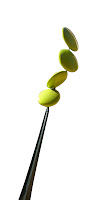Where do I start? I found this project both tiring (too many hours put into it) and exciting.
I love the idea of finding a concept/emotion or message I want to portray through design/art.
This Wallpaper project gave me the opportunity to do this through code; to create something on Processing, that would have been almost impossible to create on paper.
I think that was one of the ideas behind project one - to get us to understand how much easier it is to create some images/patterns by code rather than by hand on paper.
During this project though, I had way too many ideas. I don't know where to draw the line. This is an area I need to continue to work on. I need to do my research, find something I like, and stick to it.
With my final concepts and the development stages, I found out how to pointillize an image on Processing.
My aim in this project was to produce sketches with a 3d look. I wanted images to jump out at you. To make the viewer reach out and touch it. Or look in between the layers.
I first looked at filtering the image using filter() -maybe invert filter?
But searched some more and found exactly what I was looking for. Well, I found two versions of what I was looking for.
One source is Pointillism on www.processing.org plus https://gist.github.com/814187 and http://www.learningprocessing.com/examples/chapter-15/example-15-14/.
I also looked at 'exploding' an image to create a 3d look. I was unsuccessful. No matter how much time I put into it, the code just didn't want to obey.
The things I learnt over the week of creating my wallpaper sketches:
Example of use: Pointillism is used in sketches reflecting and magnifying single pixels at random from an underlying (invisible) photo, or image. This technique can vary and alter dramatically to create different affects from another pointillized image.
I found out that when creating a fill set colour, one can simply input 'pix' if an image is uploaded to the sketch. This will create varying colours stolen from the uploaded image from random pixels. Oh yeah, 'pix' stands for 'pixel'. :) Another thing, it isn't just shapes 'pix' for the fill set colour option is good for, you can create lines with this fill(pix....)...
I love the mouse function in sketches. The fact that each time I open up one of my wallpaper sketches, I can create a different image just by moving my mouse in a certain direction, whether it be left or right. In my sketches this creates smaller or larger shapes. In others, the sky is the limit!
Transparancy = depth!
Another major factor in designing sketches for print on Processing is the size of the file you end up with at the end. I had a big issue when it came down to getting the sketches printed at a print shop. I was turned down a number of times from many print shops, simply because my 20x40cm pdf file was way too large to print. I recommend PrintStop by the way. They were the only guys to take my usb stick and print these sketches.
Next time, I will ensure my large pdfs are converted to nice big clear jpegs for printing purposes.
For the next project - I would like to step even further outside of the 'box'; explore many options within the realm of 'transformation'.
I found this example of transformation on openprocessing:
"As a general rule you need to use programming whenever you need: variation, interaction, generation, repetition, calculation or scalability" Extracted from 'Programming, the bigger picture' by Ben Jack.
I also love this one:
PopMatrix! I see the sketch above uses popmatrix plus includes a whole bunch of variables, if statements. Lots of shapes used (consists of only shapes) rotated etc to make up the end object.
I noticed that 'cols' which is one of the boxtree parameters was used here; fill(col,255,255);
I thought that was interesting.























































